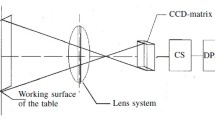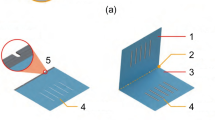Abstract
The exploitation of “intelligent” factory set-ups could enhance the competitiveness of the EU textile and clothes industries, by enabling collaborative design-and-manufacture options, while achieving economies of scope with effective exploitation of (strategic/tactical/execution) flexibility. Simulation turns to be reference aid for developing and acknowledging the appropriate set-ups and the adaptive schedules. The investigation, besides of reference concepts, summarises, for explanatory purpose, a case example related to the management of the fabric warehouse in order to grant adaptive sorting and dispatching of bolts, with on-process selective retrieval and handling of the actually used cloth, with account of fabric quality-data and of time-varying schedules. Purposely designed front-end automation rigs are required to enable the prospected up-grading options, and example robotic aids are studied, to show their actual feasibility. The considered combined-mode schedules show the benefits for prompt response leaving open middle/long horizons issues; direct checks on alternatives are provided by virtual reality tests.
Similar content being viewed by others
References
Acaccia, G. M., Chiavacci, A., Michelini, R. C., and Callegari, M.: Benchmarking clothing industry effectiveness by computer simulation, in: Proc. of the 11th European Symposium: Simulation in Industry (ESS'99), Castle Friedrich-Alexander University, Erlangen-Nuremberg, 26–28 October 1999, pp. 519–524.
Acaccia, G. M., Conte, M., Maina, D., and Michelini, R. C.: Computer aids for intelligent manufacture of quality cloths, Comput. Industry 50(1) (2003), 71–84.
Acaccia, G. M., Conte, M., Maina, D., Michelini, R. C., and Molfino, R. M.: Integrated manufacture of high-standing dresses for customised satisfaction, in: G. Jacucci, G. J. Olling, K. Preiss, and M. Wozny (eds), Globalisation of Manufacturing in the Digital Communication Era, Kluwer Academic Publishers, Boston, 1999, pp. 511–523.
Acaccia, G.M., Marelli, A., Michelini, R. C., and Zuccotti, A.: The fabric feeding management for automatic clothing manufacturing, in: G. L. Kovacs, P. Bertok, and G. Haidegger (eds), Digital Enterprise, New Challenges, Kluwer Academic Publishers, Boston, 2001, pp. 416–427.
Acar, M.: Intelligent textile machines and systems, in: M. Acar (ed.), Mechatronics Design in Textile Engineering, Kluwer Academic Publishers, Dordrecht, 1995, pp. 61–66.
Berkstresser, G. and Hunter, A.: Intelligent manufacturing and management systems for an agile US softgoods complex, NTC Annual Report S-95.2, 1995.
Bowers, M. R. and Agarwal, A.: Hierarchical production planning: The scheduling in the apparel industry, Internat. J. Clothing Sci. Technol. 5(4) (1993), 36–43.
Cardamone, J. M., Damert, W. C., Phillips, J. G., and Marner,W. N.: Digital image analysis for fabric assessment, Textile Res. J. 72(10) (2002), 314–329.
Chen, C., Racine, R., and Swift, F.: A practical approach to the apparel production-planning and scheduling problem, Internat. J. Clothing Sci. Technol. 4(2/3) (1992), 9–17.
Gersak, J.: Development of system for qualitative prediction of garments appearance quality, Internat. J. Clothing Sci. Technol. 14(3) (2002), 169–180.
House, D. H., DeVaul, R.W., and Breen, D. E.: Simulating the cloth dynamics using interactive particles, Internat. J. Clothing Sci. Technol. 8(3) (1996), 75–94.
Hunter, N. A., King, R. E., Nuttle, H. L.W., and Wilson, J. R.: North Carolina apparel pipeline modeling project, Internat. J. Clothing Sci. Technol. 5 (1993), 19–24.
Imaoka, H.: Three models for garment simulation, Internat. J. Clothing Sci. Technol. 8(3) (1996), 10–21.
Ji, Y. A., An, J. S., and Lim, K. S.: An introduction to a garment technical drawing system and its data-base construction methodology, Internat. J. Clothing Sci. Technol. 14(3) (2002), 247–250.
Kalta, M., Lowe, T., Wilson, G., and Tyler, D.: Collection and analysis of machine breakdown data for simulation of assembly teams in the clothing industry, J. Clothing Technol. Managm. 13(1) (1996), 26–40.
Kincade, D. H.: Quick response management system for the apparel industry: Definition through technologies, Clothing Textiles Res. J. 13(4) (1995), 245–251.
Leung, S. Y. S. and Tyler, D. J.: Exploring the potential of computer simulation in formulating apparel sourcing strategy, J. Clothing Technol. Managm. 11(2) (1994), 45–67.
McWaters, S. D. and Clapp, T. G.: Automated apparel processing: Computer simulation of fabric deformation for the design of equipment, Internat. J. Clothing Sci. Technol. 6(5) (1994), 30–38.
Michelini, R. C., Acaccia, G. M., Callegari, M., Molfino, R. M., and Razzoli, R. P.: Shop controller-and-manager in intelligent manufacture, in: S. Tzafestas (ed.), Management and Control of Manufacturing Systems, Springer, London, 1997, pp. 219–254.
Michelini, R. C., Acaccia, G. M., Callegari, M., Molfino, R. M., and Razzoli, R. P.: Computer integrated assembly for cost effective developments, in: C. T. Leondes (ed.), Computer Integrated Manufacturing, Vol. II, CRC Press, Boca Raton, FL, 2001, pp. 2.01–2.68.
Meyer, U.: Automation and control in textile production, in: 75th World Conference of Textile Institute – Globalisation: Technological, Economic and Environmental Imperatives, 1994.
Morse, M. J.: The CIMTEX project: computer-integrated manufacture in apparel industry, IEE Comput. Control Engrg. J. (1993).
Pargas, R. P., Peck, J. C., Khambekar, P. K., and Dharmaraj, S. K.: Solving synchronisation problems in rapid simulation of a manufacturing shop-floor, in: Proc. of the 1991 Simulation Multi-Conference on Artificial Intelligence and Simulation, New Orleans, LA, 1991.
Porat, I., Aggarwal, R. K., and Kennon, W. R.: Some aspects of control of textile processes, Mechatronics Design Textile Engrg. (1995), 75–95.
Porat, I. and Potluri, P.: State of the Art and Future Challenges in Cad/Cam for Textile Applications, Department of Textiles, University of Manchester Institute of Science & Technology, 1996.
Rosser, P. S., Sommerfeld, J. T., and Tincher, W. C.: Discrete-event simulation of trouser manufacturing, Internat. J. Clothing Sci. Technol. 3(2) (1991), 18–31.
Seesselberg, H. A.: A challenge to develop fully automated garment manufacturing, in: P. M. Taylor (ed.), Sensory Robotics for the Handling of Limp Materials, NATO ASI Series, Vol. F64, Springer, 1990.
Seyam, A. and Sun, F.: Manufacturing technology for apparel automation: Lay-up module, part II, Internat. J. Clothing Sci. Technol. 6(1) (1994), 5–3.
Seyam, A., Sun, F., McPherson, E., Clapp, T., and Little, T.: Manufacturing technology for apparel automation: Lay-up module, part I, Internat. J. Clothing Sci. Technol. 5(3/4) (1993), 44–59.
Stjepanovic, Z.: Computer-aided processes in garment production: Features of cad/cam hardware, Internat. J. Clothing Sci. Technol. 7(2/3) (1995), 81–88.
Stylios, G. and Sotomi, J. O.: Intelligent garment manufacture, in: 75th Word Conf. of Textile Institute “Globalisation: Technological, Economical and Environmental Imperatives”, 1994, pp. 285–294.
Tait, N.: Simulation: A key technology used too little, Apparel International (January 1994), 3–5.
Tait, N.: Materials handling in the garment factory, Apparel International (May 1996), 20–22.
Taylor, P. M. and Taylor, G. E.: Progress towards automated garment manufacture, in: P. M. Taylor (ed.), Sensory Robotics for the Handling of Limp Materials, NATO ASI Series, Vol. F64, Springer, 1990.
Totterdill, P.: Markets, technology and skills: Teamworking and competitive advantage in the apparel industry, Internat. J. Clothing Sci. Technol. 7(2/3) (1995), 24–34.
Author information
Authors and Affiliations
Rights and permissions
About this article
Cite this article
Acaccia, G.M., Marelli, A., Michelini, R.C. et al. Automatic Fabric Storing and Feeding in Quality Clothing Manufacture. Journal of Intelligent and Robotic Systems 37, 443–465 (2003). https://doi.org/10.1023/A:1026194432448
Issue Date:
DOI: https://doi.org/10.1023/A:1026194432448




